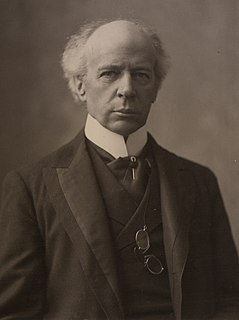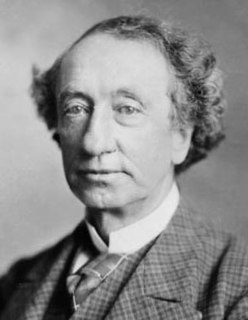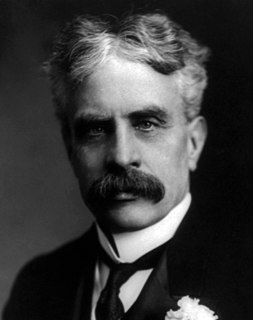
Sir Charles Tupper, 1st Baronet, was a Canadian Father of Confederation who served as the sixth prime minister of Canada from May 1 to July 8, 1896. As the premier of Nova Scotia from 1864 to 1867, he led Nova Scotia into Confederation. He briefly served as the Canadian prime minister, from seven days after parliament had been dissolved, until he resigned on July 8, 1896 following his party's loss in the 1896 Canadian federal election. His 69-day tenure as prime minister is the shortest in Canadian history.

Sir John Alexander Macdonald was the first prime minister of Canada, serving from 1867 to 1873 and from 1878 to 1891. The dominant figure of Canadian Confederation, he had a political career that spanned almost half a century.

Sir Robert Laird Borden was a Canadian lawyer and politician who served as the eighth prime minister of Canada from 1911 to 1920. He is best known for his leadership of Canada during World War I.

Sir Henri Charles Wilfrid Laurier, was a Canadian lawyer, statesman, and politician who served as the seventh prime minister of Canada from 1896 to 1911. The first French Canadian prime minister, his 15-year tenure remains the longest unbroken term of office among Canadian prime ministers and his nearly 45 years of service in the House of Commons is a record for the House. Laurier is best known for his compromises between English and French Canada.

The Progressive Conservative Party of Canada was a centre-right federal political party in Canada that existed from 1942 to 2003.
The Canada–United States Free Trade Agreement (CUSFTA), official name as the Free Trade Agreement between Canada and the United States of America, was a bilateral trade agreement reached by negotiators for Canada and the United States on October 4, 1987, and signed by the leaders of both countries on January 2, 1988. The agreement phased out a wide range of trade restrictions in stages, over a ten-year period, and resulted in a substantial increase in cross-border trade as an improvement to the last replaced trade deal. With the addition of Mexico in 1994, CUSFTA was superseded by the North American Free Trade Agreement (NAFTA).
The Canadian–American Reciprocity Treaty of 1854, also known as the Elgin–Marcy Treaty, was a treaty between the United Kingdom and the United States that applied to British North America, including the Province of Canada, New Brunswick, Nova Scotia, Prince Edward Island, and Newfoundland Colony. The treaty covered raw materials; in effect from 1854 to 1866, it represented a move toward free trade and was opposed by protectionist elements in the United States.

The Conservative Party of Canada has gone by a variety of names over the years since Canadian Confederation. Initially known as the "Liberal-Conservative Party", it dropped "Liberal" from its name in 1873, although many of its candidates continued to use this name.

The National Policy was a Canadian economic program introduced by John A. Macdonald's Conservative Party in 1876. After Macdonald led the Conservatives to victory in the 1878 Canadian federal election, he began implementing his policy in 1879. The protective policy had shown positive responses in the economy with new industries flourishing Canada's economy in the 1880s. John A. Macdonald combined three elements as a strategy for the post-Confederation economy. First, by calling for high tariffs on imported manufactured items to protect the manufacturing industry. Second, by calling for a massive expansion of physical infrastructure, such as roads and railroads. Finally, enabled and supported by the former two, by promoting population growth, particularly in western Canada. The building of the Canadian Pacific Railway, and the fostering of immigration to Western Canada. Macdonald campaigned on the policy in the 1878 election, and defeated the Liberal Party, which supported free trade. It lasted from 1879 until sometime in the early 1950s.

The 1891 Canadian federal election was held on March 5, 1891, to elect members of the House of Commons of Canada of the 7th Parliament of Canada. It was won by the Conservative Party of Prime Minister Sir John A. Macdonald.

The 1911 Canadian federal election was held on September 21, 1911 to elect members of the House of Commons of Canada of the 12th Parliament of Canada.

Sir Richard John Cartwright was a Canadian businessman and politician.

Conservatism in Canada is generally considered to be primarily represented by the modern-day Conservative Party of Canada in federal party politics, and by various centre-right and right-wing parties at the provincial level. The first party calling itself "Conservative" in what would become Canada was elected in the Province of Canada election of 1854.
Continentalism refers to the agreements or policies that favor the regionalization and/or cooperation between states within a continent. The term is used more often in the European and North American contexts, but the concept has been applied to other continents including Africa, Asia and South America. In North American history, continentalism became linked to manifest destiny and involved merging continental expansion with international growth.
Tariffs have historically served a key role in the trade policy of the United States. Their purpose was to generate revenue for the federal government and to allow for import substitution industrialization by acting as a protective barrier around infant industries. They also aimed to reduce the trade deficit and the pressure of foreign competition. Tariffs were one of the pillars of the American System that allowed the rapid development and industrialization of the United States. The United States pursued a protectionist policy from the beginning of the 19th century until the middle of the 20th century. Between 1861 and 1933, they had one of the highest average tariff rates on manufactured imports in the world. However American agricultural and industrial were cheaper than rival products and the tariff had an impact primarily on wool products. After 1942 the U.S. promoted worldwide free trade.

Post-Confederation Canada (1867–1914) is history of Canada from the formation of the Dominion to the outbreak of World War I in 1914. Canada had a population of 3.5 million, residing in the large expanse from Cape Breton to just beyond the Great Lakes, usually within a hundred miles or so of the Canada–United States border. One in three Canadians was French, and about 100,000 were aboriginal. It was a rural country composed of small farms. With a population of 115,000, Montreal was the largest city, followed by Toronto and Quebec at about 60,000. Pigs roamed the muddy streets of Ottawa, the small new national capital.
This article covers the history of the Liberal Party of Canada.
George Clifford Van Roggen was a Canadian Senator and a longtime advocate of free trade with the United States.
Protectionism in the United States is protectionist economic policy that erects tariffs and other barriers on imported goods. In the US this policy was most prevalent in the 19th century. At that time it was mainly used to protect Northern industries and was opposed by Southern states that wanted free trade to expand cotton and other agricultural exports. Protectionist measures included tariffs and quotas on imported goods, along with subsidies and other means, to restrain the free movement of imported goods, thus encouraging local industry.

This article is the Electoral history of Sir Wilfrid Laurier, the seventh Prime Minister of Canada.










